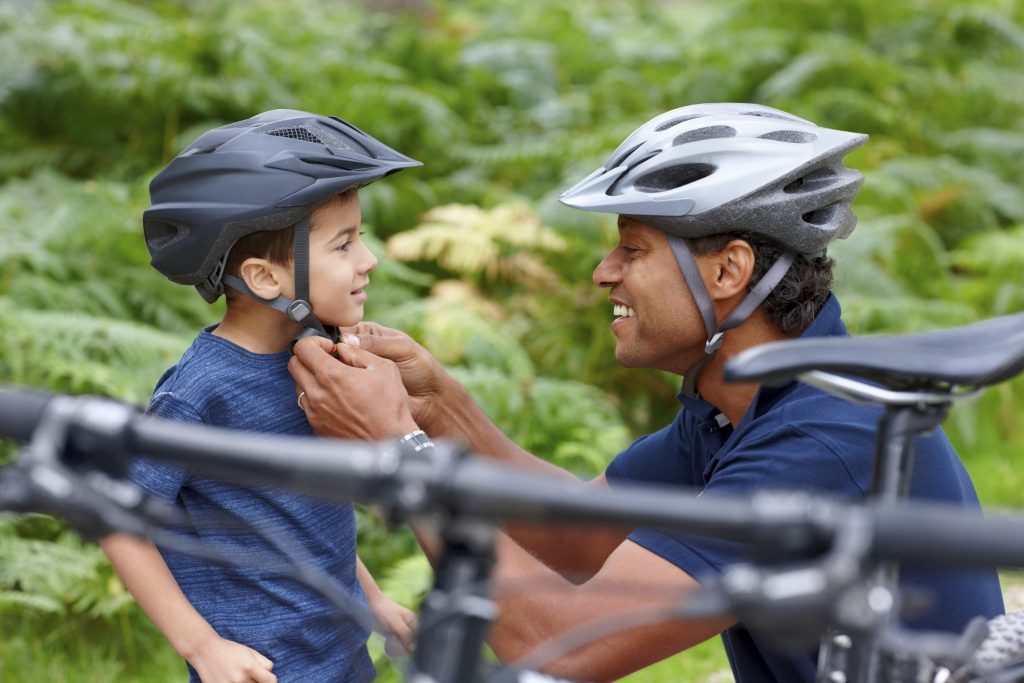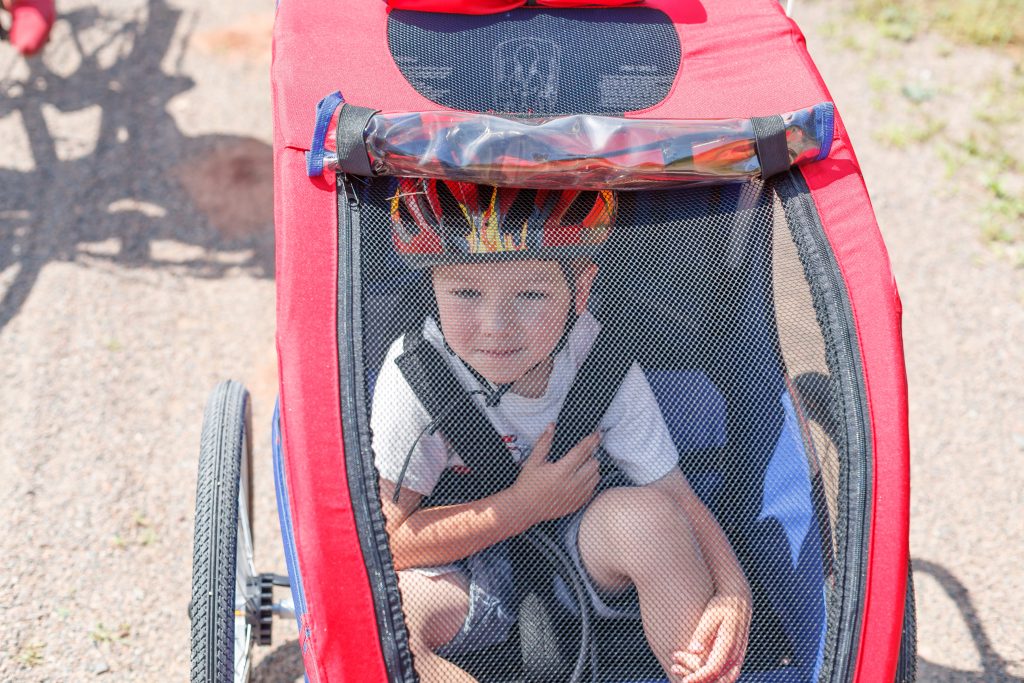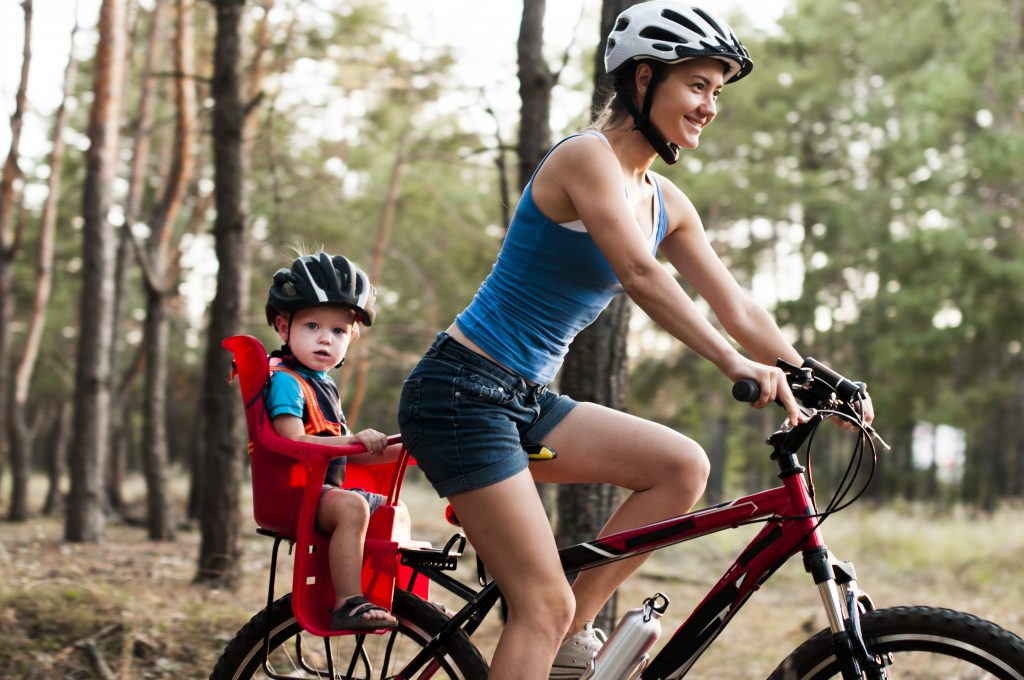Child carriers and trailers for bikes can introduce your child to the joys of bike riding, but it’s important to know the potential risks.
Injuries can happen with both products but bike trailers are considered somewhat safer because children are lower to the ground and have less of a distance to fall in a crash. Also, the weight and movement of a child in a bike carrier can throw off the balance of the adult cyclist, increasing the risk of a fall.
While trailers are the safer choice, they are more expensive than bike carriers. Trailers cost anywhere from $150 to $500, compared to $75 to $250 for a bike carrier.
Before taking your child on a bike, check with your municipal and provincial governments to ensure you are following local regulations about cycling.
Front- vs rear-mounted child carriers
There isn’t much research to confirm which type is safer, but there are advantages to a front-mounted child carrier over the more common rear-mounted type.
- A parent can see and talk to a child during the ride.
- The child is seated in the middle of the bike, closer to the centre of gravity. This allows the cyclist to get on and off the bike more steadily.
However, a front-mounted bike carrier can make steering more difficult. It can also interfere with pedalling or may not provide enough space for the cyclist’s body or knees.
It’s best to test out both types of carrier before you buy. Strap a sack of potatoes into the carrier to mimic your child’s weight and go for a ride. That way, you can determine which carrier feels more stable and comfortable to you – and whether you’re even comfortable with a carrier at all.
How to reduce chance of injuries
Whether you’re using a bike carrier or a trailer, follow these safety tips:

- Don’t use a trailer or carrier for children under one year old. Children need good neck and head control to support a helmet and to handle the movement and bouncing involved during the ride. There are no bike helmets made for children younger than one year.
- Make sure your child wears a properly fitting bicycle helmet and is always strapped into the trailer or carrier. This is critical. Be sure to set a good example and protect yourself by wearing a helmet, too.
- Stay off busy streets and follow the rules of the road with extra care. Use bike paths whenever available. Avoid riding at night; it’s particularly difficult for drivers to see trailers in the dark, because they are low to the ground.
- Make sure you are visible to drivers. Place large reflective patches on the sides and back of the trailer, as well as high-flying reflective flags on the back. Make sure your bike has lights and reflectors.
- Put a mirror on your bike handle so that you can check your child as you ride.
- Practise riding with the trailer or carrier before you take your child for a trip. Put something in the trailer or carrier that is similar to your child’s weight – perhaps a bag of potatoes – and get used to handling your bike with the new sensations.
- If you’re using a trailer, make wide turns and watch out for tipping hazards. The added length and width of a bike trailer can make it difficult to handle in some streets and narrow lanes. You’ll need to provide extra room to keep the trailer from getting caught on curbs, bushes or other objects. Avoid sharp turns; they can cause a bicycle trailer to tip over.
- If you’re using a bike carrier, don’t lean the bike against anything or use a kickstand when your child is in the seat. Whenever possible, have another adult hold the bike upright while you get on or off. Never leave a child unattended in a bike carrier or trailer.
- Don’t overload the trailer or your bike. Check and follow the weight restrictions for your trailer. If you have a basket or other storage on your bike, make sure the contents don’t throw you off balance.
- Dress your child for the weather and take breaks for drinks or snacks. Remember that your child may be cooler than you are during the ride. Do not use blankets, loose-fitting clothing or scarves that can get caught in spokes, gears or pedals. Remove drawstrings from children’s clothing. To prevent choking, do not give your child snacks or drinks during the ride. Take frequent breaks instead.
How to choose a carrier or trailer
Parachute does not endorse specific products. Canada doesn’t have safety regulations for carriers and trailers but some manufacturers choose to follow voluntary U.S. standards: look for a label that says ASTM. Check also for the items listed below.
Bike trailers should have:

- A secure harness system for each child.
- Plenty of head space for helmets.
- A hitching arm with a mechanism to prevent the bike trailer from tipping over or accidentally breaking loose.
- A sturdy metal frame and padded seats. If the trailer tips over, these features could reduce your child’s risk of injury.
- Wheel guards or non-removable sides to prevent children’s fingers from getting caught in the wheel spokes.
- Weather shields and a canopy to protect children from rain, wind and sun – but make sure there is ventilation. On a warm day, temperatures in a trailer can reach 40°C or higher.
Bike carriers should have:

- A heavy duty plastic frame.
- A high back and sides to stop your child from swaying in the seat. This could throw you off balance.
- Side protection to keep little feet away from the wheels
- A three-point or five-point harness system with a crotch strap (similar to what you have in your child’s car seat). Some bike carriers also come equipped with a padded cross bar, but this is not a safety restraint. Always use the harness.
- A secure attachment to the bike – there shouldn’t be any movement when you wiggle the carrier. Consider having a professional install it onto your bike.
- A specialty bike shop can help you choose a carrier or trailer with recommended safety components. If you’re buying second-hand, check with the manufacturer to make sure the trailer or carrier hasn’t been recalled for safety reasons.